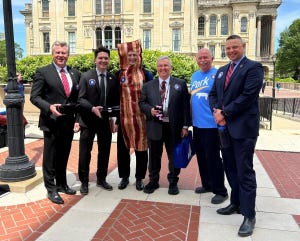USDA releases 'climate-smart agriculture' report
Legislative Watch: Ag groups urge chief ag negotiator be named; Still waiting on USDA nominees; Texas gains as Midwest, Northeast lose House seats.

USDA released its "90-Day Progress Report on Climate-Smart Agriculture and Forestry" that presents a broad outline for a climate-smart agriculture and forestry (CSAF) strategy. The plan is to make certain producers benefit from the CSAF.
Secretary of Agriculture Tom Vilsack said in the report, "With the right tools and partnerships, American agriculture and forestry can lead the world in solutions that will increase climate resilience, sequester carbon, enhance agricultural productivity, and maintain critical environmental benefits."
The report lists seven recommended elements of a CSAF strategy:
Prepare USDA to quantify, track and report the benefits of CSAF activities.
Develop a CSAF strategy that works for all farmers, ranchers, forest landowners, and communities.
Leverage existing USDA programs to support CSAF strategies.
Strengthen education, training and technical assistance for CSAF practices.
Support new and better markets for agriculture and forestry products generated through CSAF practices.
Develop a forest and wildfire resilience strategy.
Improve research.
The report reflects the comments it received from over 2,700 agricultural organizations, environmental groups, and producers. USDA plans to continue outreach to stakeholders and develop and implement strategies based on the suggestions from stakeholders.
The full report can be found here.
Ag groups urge chief ag negotiator be named
A group of over 60 agricultural organizations are calling on President Biden to nominate USTR's Chief Agricultural Negotiator. This position has been critical in addressing trade issues affecting agriculture.
The organizations said in a letter to Biden, "Because of the pressing importance of improved and expanded market access for U.S. food and agriculture we request that you move swiftly to nominate an individual to serve as the chief agricultural negotiator at the Office of the U.S. Trade Representative."
They continued: "The world is moving forward on trade agreements, and unjustified barriers to U.S. food and agricultural exports are growing. We know this Administration recognizes that bolstering rural communities is a critical component of building back better; robust U.S. leadership on agricultural trade policy is critical to advancing that agenda. We view the swift nomination and appointment of a chief agricultural negotiator as central to achieving improved and expanded market access for the U.S. food, agriculture, and seafood sectors."
Those signing the letter included the American Farm Bureau Federation, American Soybean Association, Animal Health Intitute, National Association of State Departments of Agriculture, National Association of Wheat Growers, National Chicken Council, National Corn Growers Association, National Cotton Council, National Milk Producers Federation, National Turkey Federation and North American Meat Institute.
Still waiting on USDA nominees
The administration has been slow in announcing USDA nominations. As of now, only Secretary of Agriculture Tom Vilsack and Deputy Secretary Jewel Bronaugh have been confirmed. Three nominations are waiting Senate consideration: Robert Bonnie, undersecretary for farm production and conservation; Jenny Moffitt, undersecretary of regulatory and marketing programs; and General Counsel Janie Simms Hipp.
There are nine positions waiting for a nominee to be named, including undersecretary of foreign agricultural services, undersecretary for food and consumer services; undersecretary of food safety, undersecretary for national resources and environment, undersecretary of research, education, and economics, undersecretary of rural development, assistant secretary of civil rights, assistant secretary of congressional relations, and chief fiscal officer.
Texas gains as Midwest, Northeast lose House seats
Texas will gain two congressional seats while California and a number of Midwest and Northeast states will lose Congressional seats for the next decade, according to the apportionment results announced by the Census Bureau on Monday.
According to the data, Texas will gain two seats and Colorado, Florida, North Carolina, Montana, and Oregon will each gain one. California, Illinois, Michigan, New York, Ohio, Pennsylvania, and West Virginia will each lose one seat.
The average House seat will represent 761,169 people, compared to 710,767 after the 2010 census.
The U.S. population is 331 million people, an increase of 7.4% since 2010. This is the second slowest growth rate in history. Southern states grew at 10.2%, Western states at 9.2%, Northeastern states at 4.1%, and Midwestern states at 3.1%.
Source: P. Scott Shearer, who is solely responsible for the information provided, and wholly owns the information. Informa Business Media and all its subsidiaries are not responsible for any of the content contained in this information asset.
About the Author(s)
You May Also Like


